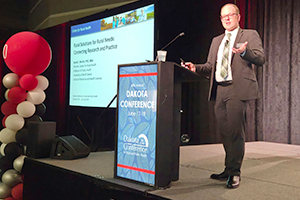Working Together to Improve Health in Rural North Dakota
By Jena Pierce on

Jacob Warren is a researcher at heart, but also understands the need for communities to find practical solutions for challenges they are experiencing. As the new director at the Center for Rural Health (CRH) and professor of population health at the University of North Dakota School of Medicine & Health Sciences, he wants to use his experience connecting research and practice to help find solutions for rural North Dakota. But first, he is working to determine what those challenges are for people in all areas of the state.
Rural communities are much more complex and much more diverse than people think.
Working as the director of CRH for six months, Warren understands that the needs of northwestern North Dakota are not the same as the needs of southeastern North Dakota. "Rural communities are much more complex and much more diverse than people think. Different parts of the state are not the same, and their solutions may not be the same either," he said during his keynote at the Dakota Conference on Rural and Public Health, held in Bismarck in June.
Community-Engaged Research
Warren shared with the audience that academic research is usually chosen by the researcher, and community need is often secondary. He described his experience using two models of research practice that instead center research around the needs of communities. The community-based participatory research model focuses on engagement with the community.
This research approach actively engages the community in the design, conduct, interpretation, and dissemination of the research findings, allowing for full partnership between communities and universities.

One example he shared using community-engaged research to implement practical solutions was when he worked with a rural county in Georgia that had identified risk-taking behavior in children as a key concern. Through research and partnership with the stakeholders involved, a one-day intensive workshop on self-esteem was developed and delivered in elementary schools.
Children with higher self-esteem are less likely to engage in risk-taking behavior, which made this program an ideal approach for addressing the community-identified priority. The program was conducted for three cycles, engaging 4th graders and then repeating with 5th graders.
A significant increase in self-esteem was reported after each intervention, allowing the community to then have a customized program they could implement moving forward that was both impactful and feasible to sustain.
Practice-Based Research
The concept of practice-based research is similar but occurs in clinical settings. The premise remains the same as community-based research in that clinical research should benefit clinical populations. But instead of partnering broadly with a community, practice-based research partners closely with providers to help them address a need identified within a clinical practice.
One example of his experience with practice-based research is a multi-year partnership with a Federally Qualified Health Center (FQHC) Network in a multi-county area in the rural South. The FQHC Network wanted to improve diabetic control and use technology to reach rural patients. Surveys and focus groups were conducted across four sites. The data was then co-published with the clinic, demonstrating that their rural patients wanted to use technology and telehealth to improve their health.
The team then received funding to put the idea into action. A new intervention was developed in partnership with the clinics and their patients that provided telehealth-delivered diabetes education to patients using the approaches they had indicated would work best for them.
After a 12-month clinical trial with 500 patients, 67 percent of participants in the program showed a decrease in body mass index and program participants with diabetes lowered their A1c by more than 2 points on average. Again, by being developed in partnership with the clinics themselves, the outcome of the research was a scalable, effective, and practical chronic disease intervention that uniquely met their needs.
How to Find Solutions
There are many models of success in rural communities that can be implemented. These models can be found in evidence repositories, including the Rural Health Information Hub, within CRH. But every model isn't a perfect fit for every rural community. Warren wants to know what priorities your community has in improving health, and how he and the team at CRH can help. One of his goals is to build research capacity at CRH, and there are vast connections and partnerships that can be strengthened across the state.
We all have assets, strengths, connections, and we need to come together and build the needed research infrastructure to serve North Dakota.
He shared with the audience, "We all have assets, strengths, connections, and we need to come together and build the needed research infrastructure to serve North Dakota."
But first he wants to know what opportunities and needs you see in serving your community. This summer, Warren is planning to travel across the state to meet with Critical Access Hospitals, Rural Health Clinics, public health districts, local health departments, and community members, to hear what needs they are trying to meet.
"Let us know what matters to your community," he said. "As a Center we want to build research activities in partnership with you so we can work together and find solutions that will meet the needs of the people you serve."


 is the communications manager at the Center for Rural
Health at the University of North Dakota School of
Medicine & Health Sciences in Grand Forks.
is the communications manager at the Center for Rural
Health at the University of North Dakota School of
Medicine & Health Sciences in Grand Forks.



